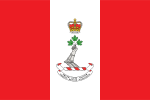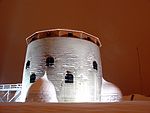Fort Henry National Historic Site
Fort Henry National Historic Site is located in Kingston, Ontario, Canada on Point Henry, a strategic, elevated point near the mouth of the Cataraqui River where it flows into the St. Lawrence River at the east end of Lake Ontario. The fort and the point on which the fort was built were named after Henry Hamilton, former Lieutenant-Governor of the Province of Quebec.A fortification was constructed during the War of 1812 to protect the Kingston Royal Naval Dockyard (the site of the present-day Royal Military College of Canada) on Point Frederick from a possible American attack during the war and to monitor maritime traffic on the St. Lawrence River and Lake Ontario. A much larger fort replaced this construction in the 1830s to maintain protection of the naval dockyard and protect the southern entrance to the Rideau Canal. The fort was restored in the 1930s and is a significant tourist attraction.
Excerpt from the Wikipedia article Fort Henry National Historic Site (License: CC BY-SA 3.0, Authors).Fort Henry National Historic Site
Fort Henry Drive, Kingston
Geographical coordinates (GPS) Address Nearby Places Show on map
Geographical coordinates (GPS)
| Latitude | Longitude |
|---|---|
| N 44.230263888889 ° | E -76.459680555556 ° |
Address
Fort Henry Drive
Fort Henry Drive
K7K 5T5 Kingston
Ontario, Canada
Open on Google Maps








